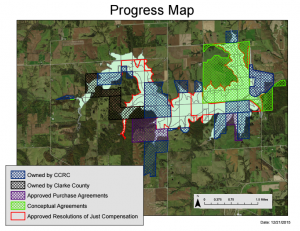The Clarke County Board of Supervisors held a public hearing on Monday to take public comments concerning the issuance of Local Option Sales and Services (LOSST) revenue bonds. The one-cent LOSST has been approved by citizen votes in Osceola, Woodburn, and Murray, and is dedicated to the current Clarke County Reservoir project. Residents attended this meeting at the Clarke County Courthouse and heard discussion, offered insight and watched the vote that approved the next step in issuing the revenue bonds.
In an interview after the hearing, Dave Beck, Project Coordinator for the Clarke County Reservoir Commission, said the county issuing LOSST revenue bonds has no additional impact on Clarke County taxpayers.
“The local option sales tax has been in place for years. The proposed revenue bonds will be paid with those sales tax revenues. No property taxes are involved.”
For over two decades, the Clarke County Reservoir Commission has been working on finding the best solutions for meeting the increasing water needs of a quickly-growing community. Through exhaustive scouting and investigation of several potential sites around Osceola, including White Breast Creek and Squaw Creek watershed areas, it was determined that the best location for any new reservoir would be in the Squaw Creek watershed northwest of Osceola. Many factors were taken into account in this decision, which was made after careful examination of fieldwork done by the USDA’s Natural Resources Conservation Service. This set of criteria included such aspects as drainage and runoff, topography, potential water yields, and land use. The more intensive land use, and the close proximity of I-35 and US-34 helped the community make the decision long ago not to develop a new water supply in the White Breast Creek watershed. The higher potential for issues with water quality paired with the likely need for more rigorous water treatment meant Squaw Creek was the best solution.
The commission has looked at many other options to help meet the growing water needs of the Osceola community and Clarke County residents. The West Lake Reservoir has been expanded and the dam raised twice to provide more water, but the watershed that feeds the lake rainfall runoff is at its practical limits. Recent studies indicate that the sustainable yield of West Lake is only 800,000 gallons per day, when the current average use is already about 1.2 million gallons per day. At the current rate of growth for Clarke County, water needs studies show about 3 million gallons are needed daily. Therefore, the proposed Clarke County Reservoir is planned to provide 2.2 million gallons per day, with West Lake Reservoir providing about 800,000 gallons per day. The Osceola Water Treatment Facility already has the means to treat those needs, but not the raw water source.
Many other possibilities have been offered and explored thoroughly since the need for a greater water yield was realized. Some proposals included constructing deep wells and hyper-treating the water, constructing a pipeline from Des Moines or Lake Rathbun and purchasing water to meet needs, and investigating at least nine other potential reservoir sites. But with the population growth as well as increased agricultural and industrial needs now and projected into the future, none of these options offered an economically viable solution, where the proposed reservoir would meet the needs.
With all that considered, over the past eighteen months, the Clarke County Reservoir Commission has been working with area residents to great success in negotiating land purchases required by state regulations for the reservoir. To date, almost 60% of the required land has been purchased or is under agreement for purchase, but there are still many conversations to be had. To finish out the land acquisition for the planned reservoir, the commission will continue to work with landowners to negotiate fair market values for their land and relocation costs. The commission is optimistic, based on conversations had with landowners throughout the area, this stage of the development could quite possibly conclude by the end of 2016.
In the light of a new law specific only to Clarke County, the commission is currently waiting on a finalized report from their engineering firm, HDR, exploring a revision into the surface area of the planned reservoir. The current proposed reservoir would be 816 surface acres of water, providing the needed 2.2 million gallons/day.
At the December 17 Reservoir Commission meeting, HDR presented an option. “Leaving the dam at the current location, but designing it differently to reduce the area impacted, they came up with a 509-acre pool that would yield only 1.2 million gallons per day. While they are still working on costs, required redesigns of the primary spillway and emergency spillway will likely cost millions more dollars than the currently planned reservoir”, said Beck. “Paying significantly more money for less water that doesn’t meet the community’s needs doesn’t seem like a good idea to me.”

Dave Beck, CCRC Project Coordinator
Looking forward into 2016, the Clarke County Reservoir Commission is looking forward to more negotiations with landowners, and the final report from their engineers.
“The Commission expects the final report on the smaller alternative site in January. That report should include costs of that smaller reservoir. At that time, the Commissioners will have some hard decisions to make,” said Beck.
In the meantime, issuing the revenue bonds will enable the Commission to keep negotiations with landowners moving forward.
“Even if the Commission should decide on the smaller site, many of the same landowners will be affected by either site,” said Beck. “It just makes sense to maintain the momentum the project has developed during 2015.”
For more information, call Dave Beck, Project Coordinator for the Clarke County Reservoir Commission, 641-782-4033, or email him at [email protected].
